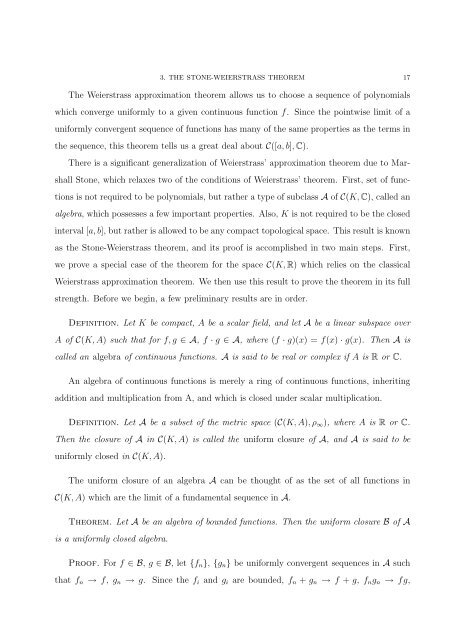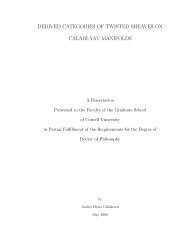FIVE MAJOR RESULTS IN ANALYSIS AND TOPOLOGY Aaron ...
FIVE MAJOR RESULTS IN ANALYSIS AND TOPOLOGY Aaron ...
FIVE MAJOR RESULTS IN ANALYSIS AND TOPOLOGY Aaron ...
Create successful ePaper yourself
Turn your PDF publications into a flip-book with our unique Google optimized e-Paper software.
3. THE STONE-WEIERSTRASS THEOREM 17<br />
The Weierstrass approximation theorem allows us to choose a sequence of polynomials<br />
which converge uniformly to a given continuous function f. Since the pointwise limit of a<br />
uniformly convergent sequence of functions has many of the same properties as the terms in<br />
the sequence, this theorem tells us a great deal about C([a,b], C).<br />
There is a significant generalization of Weierstrass’ approximation theorem due to Mar-<br />
shall Stone, which relaxes two of the conditions of Weierstrass’ theorem. First, set of func-<br />
tions is not required to be polynomials, but rather a type of subclass A of C(K, C), called an<br />
algebra, which possesses a few important properties. Also, K is not required to be the closed<br />
interval [a,b], but rather is allowed to be any compact topological space. This result is known<br />
as the Stone-Weierstrass theorem, and its proof is accomplished in two main steps. First,<br />
we prove a special case of the theorem for the space C(K, R) which relies on the classical<br />
Weierstrass approximation theorem. We then use this result to prove the theorem in its full<br />
strength. Before we begin, a few preliminary results are in order.<br />
Definition. Let K be compact, A be a scalar field, and let A be a linear subspace over<br />
A of C(K,A) such that for f,g ∈ A, f · g ∈ A, where (f · g)(x) = f(x) · g(x). Then A is<br />
called an algebra of continuous functions. A is said to be real or complex if A is R or C.<br />
An algebra of continuous functions is merely a ring of continuous functions, inheriting<br />
addition and multiplication from A, and which is closed under scalar multiplication.<br />
Definition. Let A be a subset of the metric space (C(K,A),ρ∞), where A is R or C.<br />
Then the closure of A in C(K,A) is called the uniform closure of A, and A is said to be<br />
uniformly closed in C(K,A).<br />
The uniform closure of an algebra A can be thought of as the set of all functions in<br />
C(K,A) which are the limit of a fundamental sequence in A.<br />
Theorem. Let A be an algebra of bounded functions. Then the uniform closure B of A<br />
is a uniformly closed algebra.<br />
Proof. For f ∈ B, g ∈ B, let {fn}, {gn} be uniformly convergent sequences in A such<br />
that fn → f, gn → g. Since the fi and gi are bounded, fn + gn → f + g, fngn → fg,
















